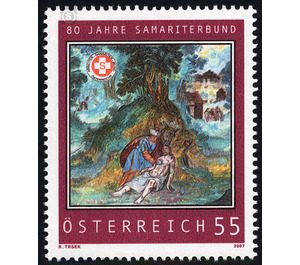80 years - Austria / II. Republic of Austria 2007 - 55 Euro Cent
Theme: Economy & Industry
| Country | Austria / II. Republic of Austria |
| Issue Date | 2007 |
| Face Value | 55.00 |
| Edition Issued | 420,000 |
| Printing Type | combination printing |
| Stamp Type | Commemorative |
| Item Type | Stamp |
| Chronological Issue Number | 1989 |
| Chronological Chapter | OOS-OE2 |
| SID | 832136 |
| In 48 Wishlists | |
From 18.-20. May the big 80-year celebration of the Arbeiter-Samariter-Bund Österreich takes place at the Rathausplatz in Vienna. The post honors this occasion with a special stamp. It shows the Samaritan scene from the fresco in the Franciscan monastery Schwaz. It all started exactly 80 years ago. It is the year 1927. Within the workers' federation for sport and physical culture (ASKÖ) an "Austrian workers Samariterdienst" is created, which has the task to provide first aid with sport and leisure accidents. As part of the workers' swimming club begins to establish its own water rescue. As early as 1932, the Arbeiter-Samariter-Bund was named as such. This makes it its task to offer first aid beyond political interests. After the Second World War, the ASBÖ, based on money and material donations, formed again. In 1948, the first emergency vehicle is put into service. By comparison, today more than 100 rescue vehicles are on the road every day in Vienna. In 1954, the ASBÖ proved its worth in disaster relief at the Danube flood, using its international contacts. During the Hungarian crisis of 1956, the ASBÖ faces a new major challenge. On the border with Hungary, about 300,000 refugees are receiving medical care and temporary accommodation. This achievement brought the Arbeiter-Samariter-Bund for the first time a greater notoriety in Austria. The next decades bring with them great social changes which the ASBÖ faces. The area "Rescue and patient transport" is extended by the offer "Social Services". The goal of helping people quickly and effectively, beyond political or other interests, has remained the same. Of course, the dimension is different than it was 80 years ago. Today, the ASBÖ with all its regional associations and groups is a strong organization that offers valuable services to the general public in many areas. For example: On peak days, the ASBÖ alone in Vienna today counts around 1,000 exits for rescue missions and patient transports. In the field of social services, the ASBÖ offers home help, home nursing, visiting service, assisted living, nursing competence centers, homeless and refugee care, cleaning service, senior alarm and vital menu. Not only that, international activities are more than remarkable. After the tsunami disaster in 2004, the ASBÖ helped thousands of people in Sri Lanka on the ground. With its housing project, the ASBÖ built around 320 houses for the victims of the tidal wave.


